by Prudence Caskey | Apr 1, 2022

To get help for someone call or text this number
Understanding Signs of Human Trafficking
The common misconception when the average person hears about human trafficking is that the victim has been kidnapped and sold into slavery across the world. The visions of young people restrained in the back of a semi tuck or cargo ship may come to mind. The reality of the matter is kidnapping of victims only happens in about 9% of these cases. The sad fact is that most victims are trafficked by someone they know and trusted at one point. Many victims even feel they are doing their trafficker a favor now and then in exchange for a new cell phone, video game, or some other type of prized possession.
Understanding the signs of human trafficking is the first step to helping the victims find their freedom. Many youth who are venerable can be influenced and controlled by savvy individuals they initially see as a trusted adult. Through research, the susceptible victims are targeted and are in over their heads before they know what has happened. Often, these victims feel stuck without any hopes of relief or rescue.
The signs to look for are subtle and for experienced traffickers, sometimes well hidden. A sudden change in appearance or attitude could be a sign of youth hanging out with a new crowd. If you notice youth that have a new friend who is considerably older, this could also be a signal that the relationship may not be healthy. Here is a sample of additional signs to look for:
- Sudden absences from school
- Repeatedly running away
- Abrupt change in attire, behavior, or relationships
- The existence of an older “boyfriend” or “girlfriend”
- Being escorted by an older male or female who is not their guardian
- Sudden existence of costly material belongings
- Homelessness
- Signs of psychological pressure, such as anxiety, depression,
- An overly submissive attitude
- Tattoos or other branding marks
- Lack of control over their schedule or money
- Unable to possess their own proof of identification
- Signs of physical trauma (like bruises, cuts, burns, or scars)
- Coached or rehearsed responses to questions
If you are a trusted adult and changes are noticed, a few well-placed questions, may help the victim open up a little. Victims may be resistant to questioning but may speak more freely with an open-ended conversation. Can you tell me more about, “the new friend’s name here”? What do you do when you hang out with “new friend”? Why did “new friend” buy you such a nice cell phone? It is not necessary to confirm abuse before calling the Florida Abuse Hotline to report suspicion. Remember, these victims can also be young adults that have been trapped inside a human trafficking ring for years. If abuse is suspected, please call Florida Abuse Hotline (report abuse for children) TEL: 1-800-962-2873 TTY: 1-800-4955-8771 The Florida Abuse Hotline accepts reports 24 hours a day and 7 days a week of known or suspected child abuse, neglect, or abandonment and reports of known or suspected abuse, neglect, or exploitation of a vulnerable adult. Please use the links below to report a child or adult abuse. National Human Trafficking Resource Center 24/7 (for adults). 1 (888) 373-7888
BeFree Textline 24/7 Text HELP to 233733 (BEFREE) Send a text for crisis support, referrals, and more – to get help for victims and survivors of human trafficking or to connect with local services.
by Claire Davis | Mar 25, 2022
Being in the great outdoors is a great way to spend your time with family! What are some ideas for activities you can do outdoors with your friends and family? Some of the best outdoor activities could include going for a hike, swimming, hunting, kayaking, or even building a campfire. With the weather still cool and a little dry here in Northwest Florida, sitting around a campfire sounds like the right kind of fun! However, it is extremely important to be sure that your campfire does not put anyone at risk of wildfires or burns.
Check out some of the fire safety tips below!
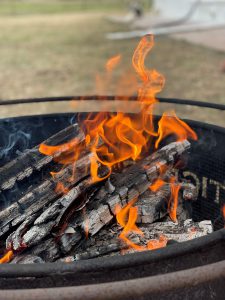
- Use a designated fire pit, if available. If this is not an option, clear a space on the ground, removing any grass or needles that could potentially catch fire.
- Build your fire downwind and away from tents, houses, or anything that is flammable. What does flammable mean? Anything that can easily set fire is flammable. The USDA suggests a minimum of at least 3 feet away from anything that can catch fire.
- Have water or something to douse the fire nearby. In the event of fire escaping its designated area, you will need to be able to put it out swiftly to prevent a wildfire. Consider a water hose that is hooked up to a water source or a fire extinguisher. Also, before leaving your fire site, make sure the fire is extinguished!
- You know the drill! Stop, Drop, and Roll! Make sure that everyone present knows how to put out a clothing fire with these three simple steps.
- Never leave children unattended around a fire. As the adult, it is your responsibility to make sure that everyone is safe! Also, store matches, lighters, and lighter fluids out of children’s sight and reach.
- Think about what you are wearing. Do not wear open toed shoes, as a spark could come off a flame and burn your toe. Instead, wear closed toed shoes while around the fire. Do not wear loose fitting clothing. If you lean over a fire with a baggy t-shirt on, chances are your shirt could catch on fire. Wearing snug-fitting clothing is an easy way to prevent this from happening.
Another “hot” topic is grilling! As we all know, fire and charcoals are extremely hot. Make safe cooking a priority, especially when it comes to outdoor grilling. With summer coming, grilling will become a more popular activity!
A great way for you youth to learn about safe grilling practices is for them to attend a 4-H Tailgate Grilling Camp! This summer,
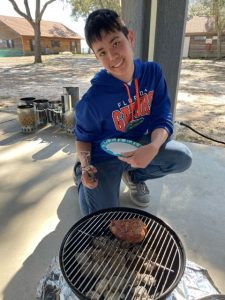
Youth learning to grill pork safely!
Calhoun and Liberty County 4-H Agents, Claire Reach and Marie Arick will be teaming up to offer this program to area youth. Youth will not only learn about the importance of fire safety, but also how to mix rubs or marinades for their meats, and how to grill different animal proteins!
If this is something you think your child or a youth you know might be interested in, stay tuned for upcoming date announcements for summer camps. If you have questions, comments, or concerns, please give us a call at the UF/IFAS Extension Calhoun County Office: (850)-674-8323.
An Equal Opportunity Institution.
Sources:
https://www.firesafekid.org/family-fire-safety/outdoor-fire-safety/
https://www.usfa.fema.gov/downloads/fief/outdoor_fire_safety.pdf
by Marcus Boston Jr. | Feb 4, 2022
My name is Marcus Boston and I’m the County Extension Director and 4-H Youth Development Agent in Leon County, Tallahassee FL. I’m originally from Gainesville Florida and have worked for the Leon County Extension Service as a 4-H Extension Agent, for 29 years.
I was born and raised in Gainesville FL., the location of the State 4-H office but was never involved in 4-H as a youth. I graduated from Buchholz High School in Gainesville Florida and earned a football scholarship to attend school and play football for Florida A&M University (FAMU) in Tallahassee. As a result of my accomplishments on and off the team, during my senior year, I was awarded the prestigious Alonzo Smith “Jake Gaither” Award. I completed my B.S. degree in Agribusiness and while working as a graduate assistant coach on the football team, I completed my M.S. in Agricultural Sciences. Prior to starting graduate school, I worked as a Sideline Commentator for the Florida A&M football games that were aired on a local radio station. After completing graduate school, I began my professional career as an extension agent with Florida A&M University and the University of Florida working primarily with 4-H Youth Development.
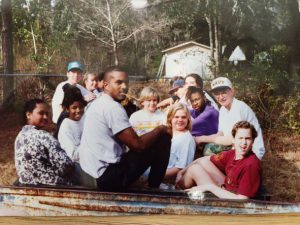
Marcus joins Leon County 4-H Leadership Club fun day activity in the early 90’s
When I started in Leon County one of my first assignments was to make a personal visit to all the existing 4-H clubs in the county at that time. After meeting all the wonderful volunteers and youth involved in our Leon County 4-H program, I was inspired by all the fun educational projects the youth were involved in and encouraged by the commitment and passion of the volunteers that oversaw the clubs. It is this commitment and passion that still exist today and that encouraged me to work extra hard to recruit and train volunteers so there could be more clubs for youth to join.
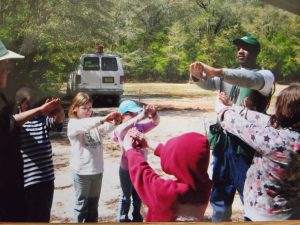
Marcus Boston teaching youth how to determine which eye is dominant before archery class
The establishment of my Environmental Education/Stewardship Program is one of my most successful programs here in Leon County. This program includes a series of smaller programs developed and carried out with the primary objective of educating our youth about the importance of conserving, protecting, and appreciating our environment and how they can become environmental stewards in their respective community’s. These experiences are tailored to equip youth participants with the information they need that will help them make logical decisions on environmental issues that may arise as they enter adulthood. In a few years these youth could be accountable for attitudes, perceptions and policies that affect our environment as well as our soil. A few of the environmental focused experiences that I developed and carried out during past several years as part of our Leon County 4-H program are: 4-H Ecology Field Day, 4-H Eco-ventures Spring Break Camp, Wild About Water Day Camp, The Talking Trash Day Camp, Going Green Day Camp, No Woods Left Behind Day Camp, Trees and Bows Day Camp, 4-H Wildlife and Outdoor Recreation Camp at Jubilee, and residential camp at 4-H Camp Cherry Lake held in Madison FL.
As a certified archery and canoe instructor, I’ve had the pleasure of teaching thousands of youth communications and safety skills using a canoe and a bow and arrow as the vehicle of choice. Both of which I’m still involved to this day. In an effort help young people learn the life cycle, I have taught the 4-H Embryology program in several schools in Leon County. This program has provided the opportunity for hundreds of students and teachers, to watch chicks hatch out of their eggs right before their eyes in their classroom…an experience they never forget.
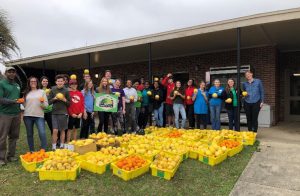
Leon County 4-H Camp Counselors kickoff counselor training with gleaning 1,300 lbs. of fruit to provide for homeless shelter
The Leon County 4-H Camp Counselor Training Program has also served as one of my most successful teen leadership programs. I have enjoyed recruiting, training and equipping hundreds of teens with the skills and knowledge they need to: Manage campers at our residential camp, understand the “ages and stages” of the youth they supervised, apply strategies for teaching classes at camp, and most important, keeping camp safe for all in attendance. Due to the success of this program, former counselors from our counselor training program are viewed and recruited as potential camp staff for our State 4-H camps each year.
I have also enjoyed providing opportunities for thousands of youth in Leon County Schools to participate in The 4-H Tropicana Public Speaking Program (now known as the Florida 4-H Public Speaking Program sponsored by Florida Power and Light) which annually provides an opportunity for over 7,000 Leon County 4th, 5th, and 6th graders to develop, write, and present a speech on a topic of their interest. With so much emphasis on texting and posting…this program continues to provide a platform for young people to develop their oral communication skills which is crucial as they graduate and enter the work force.
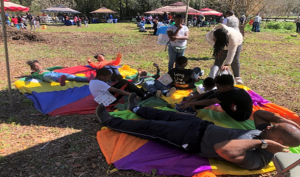
Marcus Boston is demonstrating fitness techniques with attendees during Youth Extension Day in Leon County.
I have also been a Project Learning Tree(PLT) facilitator for over 20 years and have help to train over 500 college students from Florida State, Flagler College and Florida A&M University in how to teach youth environmental education using the PLT curriculum.
The last six years as County Extension Director has provided me an opportunity to promote UF/IFAS Extension by managing and working with my faculty in providing researched based information in the form of workshops, field days, 4-H clubs, seminars, virtual and hybrid webinars and school enrichment programs in an effort to help youth and adults in the Leon County Community find the Solutions For Their Life. I have always believed that active participation in 4-H provides youth the tools in life to be successful in whatever direction they choose to go.
by Rachel Pienta | Jan 21, 2022
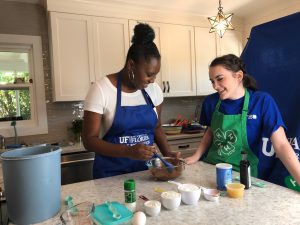 Healthy Living is one of the 4-H’s. While your club may not specifically focus on what is traditionally considered to be “healthy living” activities, you might be surprised about much your 4-H club is contributing to the mental and physical well-being of youth members. After we recognize that all our clubs have a role to play in implementing healthy living strategies across the county 4-H program, we can start to consider ways to be intentional in how we incorporate healthy living into 4-H activities and projects.
Healthy Living is one of the 4-H’s. While your club may not specifically focus on what is traditionally considered to be “healthy living” activities, you might be surprised about much your 4-H club is contributing to the mental and physical well-being of youth members. After we recognize that all our clubs have a role to play in implementing healthy living strategies across the county 4-H program, we can start to consider ways to be intentional in how we incorporate healthy living into 4-H activities and projects.
What does a 4-H Healthy Living program include? A 4 H Healthy Living program or strategy is any activity or program component that can help youth lead lives that balance physical, mental, and emotional health.
According to the National 4-H Council, 4-H Healthy Living programs include objectives that can help “empower youth to be healthy – body and mind – with the skills to make healthy decisions and lead healthy lifestyles. Having the confidence and skills to lead healthy lifestyles not only improves overall well-being; it enables youth to tackle life’s challenges today and become leaders in their lives, careers, and communities as they grow into responsible adulthood” (National 4-H Council, 2021). Your club focus might fit into one of the following program areas: mind, body, leadership, or mentorship.
As a club leader, you may encourage your youth to adopt goals and projects that will cover multiple program areas. Introducing healthy living during club meetings is another way to incorporate these concepts and help youth develop healthier habits.
With so many possible topics to consider, it may seem overwhelming to choose a starting point. In this article, a few suggestions will be explored.
Sleep
It may be surprising to learn that youth, like adults, are not getting enough sleep. Regularly missing hours of sleep or experiencing poor sleep quality can contribute to a variety of issues for youth. The Sleep Foundation is one resource to use for tips on how to encourage our 4-H members to adopt better sleep habits (Pacheco, 2021).
Some ideas for helping your 4-H youth learn about the importance of sleep and how to develop better sleep habits include the activities and lessons listed in the links below this paragraph. Consider challenging your youth to set healthy sleep goals for one month. Discuss the potential benefits during your goal setting activity. At the end of the month, discuss how youth felt on days when the sleep goals were met and how they felt on days when they did not meet their goal.
Activity for Teens (Intermediates and Seniors)
University of Wisconsin Extension. 2007. “4-H Get Fit, That’s It. Lesson 2: Are You Getting Enough Sleep.” Link to activity: https://api.ag.purdue.edu/api/DepotWS/File.ashx?t=f&i=98730
Activity for Elementary School Age (Juniors 4-H Members)
The Nemours Foundation. 2015. Sleep. Kids’ Health in the Classroom.
https://classroom.kidshealth.org/classroom/3to5/body/functions/sleep.pdf
Hydration
One way to incorporate a healthy living strategy into your 4-H program is offering water at all your meetings and limiting the inclusion of other beverages. A 4-H lesson on hydration can include STEM principles as youth can calculate their daily water needs based on their body weight. A fun way to encourage water consumption is to personalize reusable water bottles as a club activity and to award points to youth who remember to bring their bottles to meetings and activities.
All Ages Lesson and Activity
National 4-H Council.2020. How Much Water Do You Need? 4-H Healthy Living Activity Guide.
https://4-h.org/wp-content/uploads/2019/04/4H-Healthy-Living-Activity-Guide.pdf
Other Ways to Incorporate Healthy Living into Your Club Programs
Activities designed to improve sleep and hydration are only two of many possible ways to incorporate healthy living into your 4-H program. Healthy Living activities can incorporate exercise, nutrition, and ways to improve and maintain mental health.
Resources
Caruso, L.; Shelnut, K.; Kauwell, G. 2017. Hydration Myths. UF/IFAS Extension. Retrieved January 16, 2022 from https://edis.ifas.ufl.edu/publication/FY1409.
National 4-H Council. 2021. Healthy Living. Retrieved January 16, 2022 from https://4-h.org/parents/healthy-living/.
Pacheco, D. 2021. Children and Sleep. The National Sleep Foundation. Retrieved January 16, 2022 from https://www.sleepfoundation.org/children-and-sleep.
University of California 4-H Youth Development Program. 2022. Sleep for Better Living. Retrieved January 16, 2022 from https://4h.ucanr.edu/Projects/HealthyLiving/Sleep_for_Better_Living/
by Allison Leo | Jan 6, 2022
The holidays are a joyous and wonderful time of year, but can also be very busy time, and at times, overwhelming. Now that we are back it is time to Children shift into the organized, orderly school day from that unstructured holiday break schedule. As a result, it is inevitable that children may feel some degree of stress from these transitions. Children and teens are still learning to regulate emotions, making them more susceptible to change’s resulting in stress.
Mindfulness is the act of creating awareness of your surroundings, emotions, and physical self in the present moment. It helps you connect to the world around you, while providing cognitive, social, and emotional benefits. Practicing mindfulness is not just for adults. Children can reap a multitude of benefits from learning and practicing mindfulness. Mindfulness equips children with the ability to adjust and deal with conflict encountered in their daily lives. It can also help children foster an optimistic outlook in life, react to stress in a healthy way, and develop a positive self-concept.
The practice of mindfulness is foreign to some adults, making it tricky to teach and model for young children. The best thing to do is keep the message simple and focus on modeling the behaviors. Being taught by an adult that models mindful behaviors daily will assist youth in mastering the techniques. Below are a few mindfulness activities you can do at home as a family or in a group learning environment, such as a 4-H club meeting.
Enjoy Nature
Going on a mindful walk is a simple way to help clear your mind and restore your focus. Taking a nature walk around your neighborhood or park is an easy way to exercise your mindfulness skills and enjoy nature. You can make it exciting by telling them you are going on a “mindfulness safari” and the goal is to see how many different birds, insects, and animals you can find on your journey. Below are some tips for going on a mindful walk:
- Start at a slow pace and gradually increase as the walk continues.
- Pay attention to the feeling in your legs and feet as you take each step. Then, notice how your arms and torso feel as you walk.
- Notice any smells around you.
- Listen to the variety of sounds around you. Notice if the sounds are close or far away.
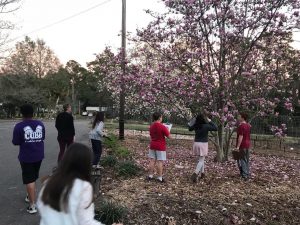
Talking a walk in nature is a simple way to practice mindfulness Photo by Allison Leo
Meditate
Contrary to what you may think, you do not have to sit silently on the ground with your eyes closed to mediate. You can meditate while you are walking, eating, or doing household chores. The goal of meditation is to slow down and be in the moment. Guided meditation led by a family member are a way to relax and help reduce stress. Below is guided meditation titled “Relationship Fingers” from the University of Minnesota Extension.
Relationship Fingers – Start by holding out your hand with your thumb pointed towards yourself. Take a breath. For each finger we are going to be focusing on a relationship we have with someone. There is no ‘right’ person so don’t worry about who you choose.
- Start by holding your pinky finger and think of someone who is far away from you. Take a breath for them. Really look at that relationship. What do you notice?
- Next focus or touch your ring finger. Think of someone who is leaning on you right now or who may be more vulnerable in this moment. Take a breath for them. Really look at that relationship. What do you notice?
- Hold or focus on your middle finger and think of a leader in your life. Take a breath for them. Really look at that relationship. What do you notice?
- Focus on your pointer finger and think of someone who is close to you. Take a breath for them. Really look at that relationship. What do you notice?
- Last, hold or focus on your thumb. Consider the relationship you have with yourself. Take a good look. What do you notice? What are you committed to? Take one last breath and shake it out.
Gratitude
When we feel and express gratitude to people in our lives, it creates loving connections, builds trust, and makes us feel joyful. Gratitude can be shown by giving someone a hug or telling them how much you appreciate them. Gratitude journals can easily be made at home or you can print off a pre-made template. This version is simple and is a great start for kids: https://researchparent.com/gratitude-journal-for-kids/.
- What’s the best book you’ve ever read? What did you like best about the characters?
- Name one thing that makes you smile every time you hear or see it. Why?
- Describe one thing that made you feel cozy today.
- Who is the one friend you can always rely on?
- What are five things you are looking forward to next year?
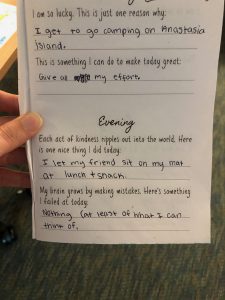
Gratitude Journals are a simple mindfulness activity kids can complete every day
Walker, K., Sharpe, K., Anderson, M., Caines, T., Johnson, C., Kennedy, D., Nguyen, K., Odendahl, S., & Santl, K. (2021). Social Emotional Wellbeing: A Guide to Support Youth Thriving. St. Paul: Regents of the University of Minnesota.
by Marie Arick | Sep 27, 2021
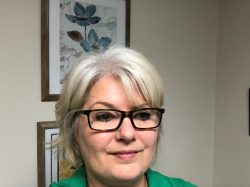
Marie Arick
Greetings, my name is Marie Arick and I am the County Extension Director, 4-H and Family & Consumer Sciences Agent in Liberty County. Beginning in 2019, I stepped into this complex, but rewarding position and have worked with volunteers, community partners and other Agents on some amazing projects.
The 4-H program provides a diverse array of opportunities for youth ages 8 to 18. One great example is the Liberty County Livestock Club. This club provides a variety of animal projects and agricultural judging opportunities. As an Agent, I support my volunteers with curriculum, training opportunities and fund raising. This club successfully fund-raised enough money to buy a set of portable livestock scales to aid with animal projects.
School enrichment is a large part of 4-H programming for Liberty County youth. The two most successful are the Ag Adventures and the Embryology in the Classroom programs. Ag Adventures introduces youth to many crops and their uses. While teaching cotton in the field during this program, it surprised me how many youths did not know that our ‘paper’ money contains cotton. With embryology, each year is met with excitement when we enter the classroom with the incubators and eggs. The daily lessons include learning the parts of the egg and following the growth of the chick. Egg candling sessions allow me the opportunity to see how much the kids have learned and there is no shortage of enthusiasm when the chicks hatch. While Covid-19 did inhibit Ag Adventures for 2020, it did not stop Embryology. All incubators and supporting equipment along with the eggs were delivered to the schools. Lesson videos were created and other supporting materials were all placed on a closed Google site for the teachers to utilize.
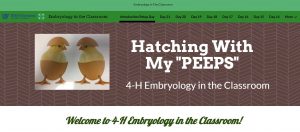
Embryology Google Site
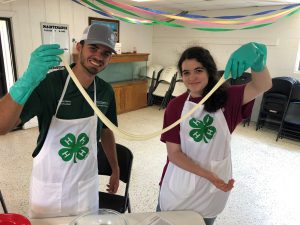
4-H University Cheese Making
As an Agent, one experience that never gets old is to ask a group of 4-H youth if they think they can transform a gallon of milk, using a few additional ingredients and a recipe, into mozzarella cheese. I absolutely love watching the skeptics successfully participate in the workshop and create their mozzarella cheese. In the process, these youth learn about food safety, kitchen safety, recipe literacy and adherence. The ‘learn by doing’ motto drives this experience.
Prior to adding 4-H to my Extension Agent assignment, I still incorporated youth into my Jackson County Family & Consumer Sciences programming, specifically culinary arts. Cooking is a life skill, we all eat! What better way to introduce food safety, kitchen safety, nutrition, and a variety of food preparation methods to youth than through culinary arts. Once I transitioned into a 4-H role, I added cheese making, grilling, food challenge, food preservation and more. Kids are more likely to try a new food, or an old favorite prepared in a healthier manner, if they make it themselves.
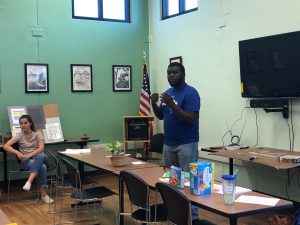
Carlos Staley, UF Intern
The above programs have shown great success, but 4-H offers a broad range of programs and there is something for everyone. My reward is each child’s success. It is even more gratifying when a former high school student that participated in the culinary arts school enrichment program for two years is now attending UF studying food science. The icing on the cake, so to speak, is when he becomes your UF summer intern!
I am a Mississippi State University graduate with a BS in Exercise Science and a MS in Health Promotion. After a long stint in the medical field, I transitioned to my second career choosing Extension. I began working with Texas A & M AgriLife Extension prior to transitioning to the University of Florida IFAS Extension in 2015. Extension is extremely rewarding, but in my down time I enjoy kayaking, gardening, and reading.














